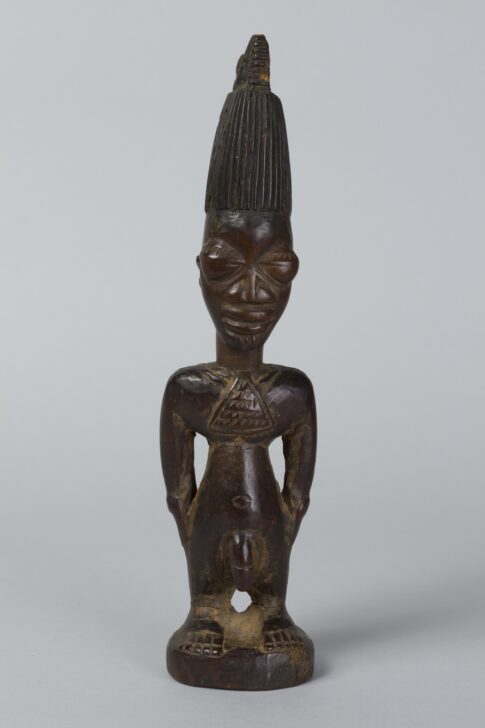Male Twin Figure
Yoruba

Description
Subject Matter:
Up until the 1980s, Ere ibeji were small figures used by Yoruba peoples in the worship of twins. This tradition has largely been replaced by portraits and plastic dolls. Twins are thought to be two bodies sharing one soul, so to placate, as well as, embody the spirit (emi), a figure (ere) would be carved to represent a deceased twin (ibeji). Yoruba peoples have the highest rate of twins per birth in the world, and in the past, high infant mortality meant many twin figures were carved. The ere ibeji was treated as a living person, regularly fed, washed, clothed, and carried. As a center of this ritual activity, these twin figures transformed from a memorial to an embodiment of the deceased twin that allowed them to be present to the living. In addition to housing the spirit of a deceased twin, ere ibeji also represented the Yoruba ideal of good character. Part of what constitutes good character is a sense of composure or ‘coolness’, called itutu. Many aspects of ere ibeji embody this sense of ‘coolness’. The calm face with serious, sealed lips and a poised stance with hands at the sides is a position of spiritual alertness that reflects ‘coolness’ and thus, good character. After being carved, the head of the twin figure would be rubbed with an indigo dyed cloth and some hairstyles/headgear were painted with blue pigment, as blue is the color of ‘coolness’. Twins are also associated with Shango, the Yoruba orisa (or god) of thunder, and the protector of ibeji, as twins are called “children of thunder”. Some aspects of ere ibeji reference Shango, such as the rubbing of the twin figure with red camwood powder, as Shango is associated with the color red, and plaited hairstyles, as Shango is often depicted with plaited hair. The triangular carving near the neck may be a carved Islamic amulet, called tira.
References Cited:
Doris, David. 2004. Yoruba Images and Aesthetics. Ann Arbor, MI: University of Michigan Museum of Art.
Drewal, Henry John, John Pemberton and Rowland O. Abiodun. 1989. Yoruba: Nine Centuries of African Art and Thought. New York: Center for African Art.
Lawal, Babatunde. 2012. Visions of Africa: Yoruba. Milan: 5 Continents Editions.
Micheli, C. Angelo. 2008. "Doubles and Twins: A New Approach to Contemporary Studio Photography in West Africa." African Arts 41, no. 1: 66-85.
Nicklin, Keith. 1991. Yoruba: A Celebration of African Art. London: Horniman Museum.
Thompson, Robert Farris. 1983. Flash of the Spirit: African and Afro-American Art and Philosophy. New York: Random House.
Physical Description:
Standing male figure on a round base with both arms placed at the sides. There is a triangular carving, possibly an amulet, around the neck and back. The figure has a conical coiffure with vertical grooves. The coiffure terminates in two smaller conical projections.
Usage Rights:
If you are interested in using an image for a publication, please visit https://umma.umich.edu/request-image/ for more information and to fill out the online Image Rights and Reproductions Request Form.